Try this: go to any page on your website and count the marketing claims you make. How many times is your business described as easy, smart, effective, trusted, reliable? Are there half a dozen claims? Ten? More?
Now try this: look at the same page and count the number of times you supported these claims with evidence. How many data points, statistics, case studies and testimonials are there? Are there two of these? Five? Zero? There probably aren’t a lot.
The point is this:
Every one of your marketing claims should be supported by evidence.
And the easiest, most effective evidence you can add to a website is a testimonial.
You’re about to dive into the complete guide for website testimonials. We’re going to answer the top questions: Where to use them, how testimonials are written, how to get testimonials and why testimonials are effective. We’ll add customer testimonial examples throughout.
First things first…
Why are testimonials effective?
Effective testimonials increase your conversion rates. What are the benefits? They build trust by acting as a third-party endorsement, triggering the conformity bias, also known as the bandwagon effect.
In this way, testimonials are an important form of social proof. Social proof is one of two types of evidence you can include on your website.
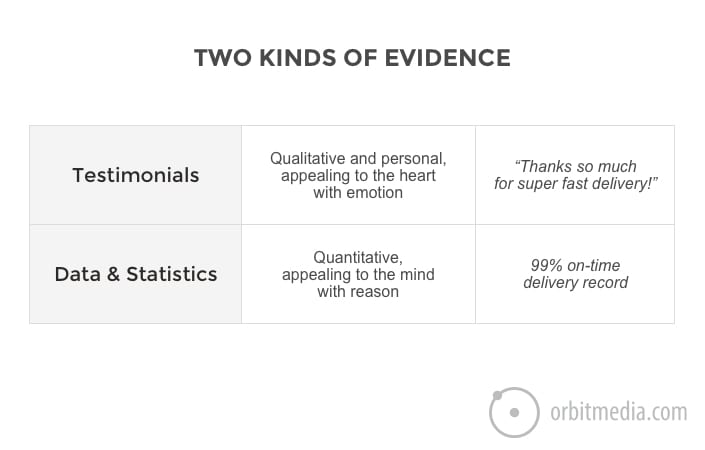
To build a really compelling website, use both. But start with testimonials.
Note: Endorsements vs. Customer testimonials – An endorsement is typically a well-known influencer giving their public support for a brand. But a testimonial is from a customer or client. They may be an unknown person to the reader, but they have personal experience with the product or service. Since they’re a paying customer, the testimonial is authentic, like a review.
How to get a great testimonial
There are two ways: ask for them and catch them as they flow past. The first approach is faster. The second approach is easier.
1. Asking for testimonials
Start with your super fans. These are your happiest clients and customers. They may have already offered to be a reference so they won’t mind the request. They might really want to help you!
Here’s an example of an email that asks for a testimonial:
Hi there, Bob.
I’m writing to ask if you wouldn’t mind giving us a short testimonial for our website. We’re updating a few pages, and I’m hoping to add something from you. It would link back to your site, so it’s actually a good thing for your SEO.
Would this be ok with you? If this makes you even a little bit uncomfortable, no worries at all. But if you are ok with it, I can send you a very short blurb for you to review, or you can write a sentence or two and send it over. Whatever is easiest for you.
Thank you, Bob!
Warning! If you write and post without the review and approval of the person you are attributing it to, it’s fake. It’s also not legal. But if you write a draft and then allow the customer to make edits and give approval it’s real and legitimate.
Now let’s break it down. This email needs to be short, considerate and easy to respond to, whether they respond with a no or a yes.
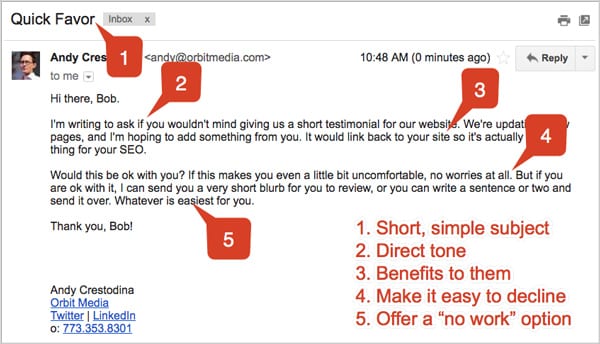
As a bonus, this offer would include a link back to them, which is a good thing for them. We’ll assume they know how links work in Google …if they don’t, just share the video on that page!
An easy offer that actually helps them? How could they refuse!
Did they say yes? Great. Now say thank you. And I don’t mean a short email message. It’s time to go overboard on gratitude with a handwritten note, a LinkedIn recommendation or something else unexpected. Try a few of these 15 unexpected ways to say thank you.
2. Listening for testimonials
Testimonials happen every day. Or at least the seeds of them do. A smart marketer knows how to spot these seeds. Here’s what they look like:
- Grateful email messages…
Thank you so much for a job well done. - Social media love…
You guys are the best! Keep up the great work! - Happy handwritten thank you notes…
I just wanted to let you know that it’s been great working with you. - Gushing in-person gratitude…
You’ve been so helpful. Is there anything I can do for you?
If you’re any good at your job, you see these from time to time (if you don’t, there are bigger problems you should fix before worrying about getting testimonials). The key is to spot them, then slow down and make the most of them.
- Save them in the “Good File.” Keep a folder of emails or screenshots from these appreciative moments.
- Reach out with a reply immediately, thanking the person for taking the time. Never, never ignore these messages. That would be rude.
- If appropriate, ask the sender if they wouldn’t mind letting you use some of those words on your website.
Pro tip: Getting LinkedIn recommendations – If the happy message you spotted was more about you than the company you work for, ask the person to recommend you on LinkedIn. This really is the key to getting LinkedIn recommendations. Just ask someone nicely at the right moment.
So now we know how to spot them in the wild and how to ask for them. Either way, someone needs to write them. Who writes the testimonial depends on where it came from. Here are the writing tips.
How are testimonials written?
The writing is key. How it’s written will determine it’s effectiveness. Here are three writing tips for great testimonials.
1. A good testimonial is short
Long testimonials are unlikely to be read by visitors. Look at this example of a long, rambling testimonial…
“I just wanted to share a quick note and let you know that you guys do a really good job. I’m glad I decided to work with you. It’s really great how easy your websites are to update and manage. I never have any problem at all.
My new site is so much faster and easier to work with than my old site. It used to take me an hour or more to update a page and I would still sometimes screw things up.
Now it’s almost like having a designer right here with me. I just choose the page, make the change and click save. It’s so simple.
Thanks, guys!”
It might get scanned, but it’s unlikely to be read. So keep it short. We recommend 30-50 words total.
ProTip! If you do have longer testimonials, you can bold the most impactful words to guide visitors attention to the best parts.
2. A good testimonial is direct
Put the most impactful statement at the beginning. Edit it so even if people read just the first few words, they get the meaning quickly. Here’s that same example, made shorter and without the extra words at the beginning…
“You made it so simple. My new site is so much faster and easier to work with than my old site. I just choose the page, make the change and click save.
Thanks, guys!”
Ask yourself: which of the words in the testimonial are the most compelling? Which words align best with the hopes/fears of the visitor? Frontload the testimonial with those words.
3. A good testimonial is authentic
Everything you say and write is marketing, and people know it. You can’t help it! But when your audience says it, it has the chance to be unexpectedly candid. Even blunt. It’s virtually impossible for a marketer to write copy as authentic as a customer. Check out this example:
“Wow. I just updated my site and it was SO SIMPLE. I am blown away. You guys truly kick ass. Thanks for being so awesome. High fives!”
That’s a tone so authentic, it’s disarming. Don’t try to write this way. Let your customers do it for you.
When you say it, it’s marketing. When they say it, it’s social proof.
What should testimonials include?
The more information in a testimonial, the more credible it is. Testimonials should include the person’s name, title, company and picture. The least credible testimonials include just the person’s initials.
Compare these examples:
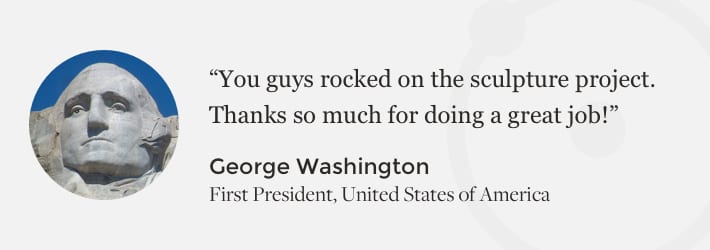
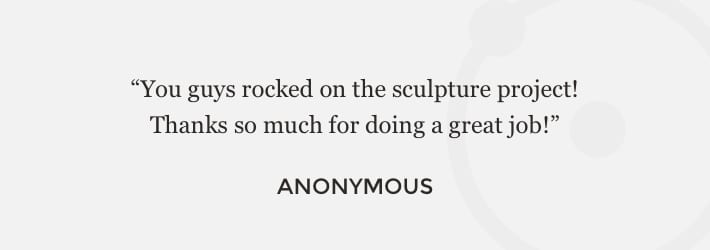
The testimonial text is the same. But which of these is more credible, trustworthy and compelling? The biggest difference is the face. Faces will make your testimonials more personal, more real.
Pictures of faces are super powerful in marketing and a key tactic in neuromarketing web design. Basecamp once ran an A/B test that found including the face of a happy customer increase conversion rates by 102.5%.
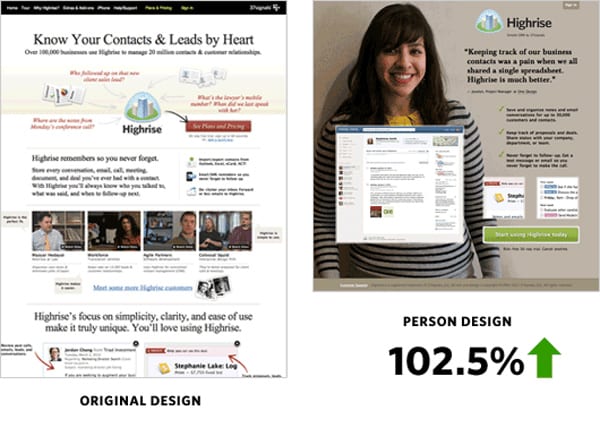
(source: Behind the scenes: A/B testing part 3)
Bonus: Add the logo of the company. This is especially effective if the company is well known.
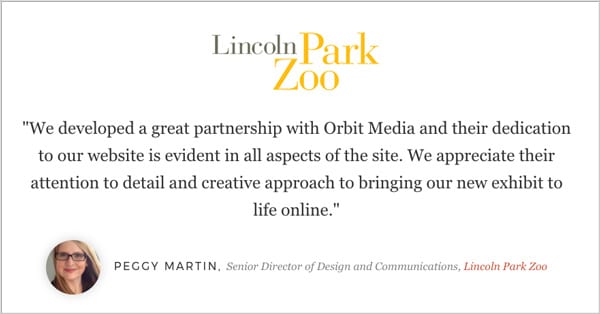
But my clients won’t let me use their names or company names. What can I do?
This is a common problem, and there is no easy way around it. If you cannot find any happy clients willing to let you put their name on your website, anonymize the testimonial by using initials and the industry.
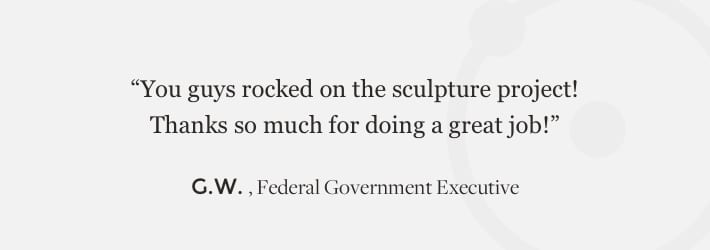
It’s not ideal, but it’s better than nothing. And there are other options. Testimonials are great, but there are other kinds of evidence we can add to our websites.
 |
“We know that more than 92% of all consumers and approximately 84% of all B to B buyers report that a ‘recommendation’ from someone they trust is the top influence on their purchase decision. So, clearly, recommendations and testimonials are vital. However, many companies don’t allow their employees to publicly endorse products or services – and many consumers don’t make the time to recommend. There is another way. Research tells us that simply having someone ‘like’ or ‘share’ your content is regarded by many as an endorsement. And, if you bring customers in for a roundtable discussion – with moderators and experts – and share that content (with permission, of course), it is also often regarded as an endorsement.” – Paul M. Rand, @paulmrand, President/CEO of Critical Mass/Zocalo and author of ‘Highly Recommended’ (McGraw-Hill). |
Finally, here’s a super powerful tip from Jen Havice on one more thing to add to your testimonials:
 |
“The best way to give your testimonial a boost is by adding a compelling summary sub-headline above it. This could be as simple as pulling a powerful quote from a longer testimonial or creating your own copy that nicely sums up the value of the testimonial. By adding a sub-headline, you’ll not only draw more attention to your testimonial but entice your visitor to actually read what should be your most powerful form of social proof on your site.” – Jen Havice, @jenhavice, Conversion Copywriter, Make Mention Media. |
Jen shared this example from Calcworkshop. If your testimonials are long, this helps make them more scannable.

ProTip! Video is far more powerful than any of the formatting mentioned here. Video testimonials may be the single most powerful piece of content that you can add to your website. We’ll share our best tips for that tactic in a future post…
Where to use testimonials?
So now you’ve got ‘em. Where should you put these testimonials? How do you add them to your website? This tip might surprise you. But it makes sense when you think about it…
Never make a testimonials page. Make every page a testimonials page.
The reason is simple: visitors rarely go to testimonials pages. They can smell the marketing a mile away.
There is no expectation that they’ll get any information except a sales pitch. That’s why testimonials pages get less traffic than other pages. Putting your social proof here hides it from your visitors.
Here is what the Analytics typically looks like on a testimonials page. You can see that there are 30 pages on this website visited more often than this page. It’s never a popular page.
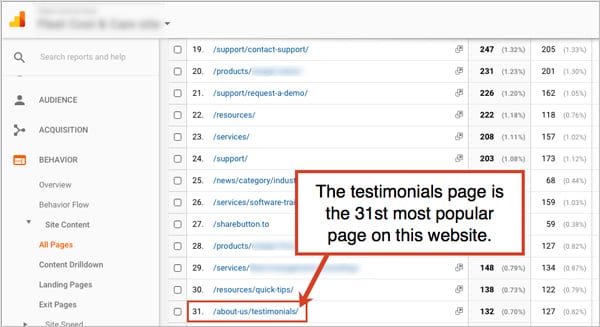
Putting them all together on one page also takes them out of context. They aren’t next to the messages they need to support. So here are three guidelines on where to put your sparkling new bits of social proof:
1. Put the testimonial next to the product or service it mentions.
Here’s how we support those marketing claims. Does the testimonial mention a product or service? Put it on that product or service page. Does it mention your speedy delivery times? Put it on the shipping page.
Here’s an example of how a testimonial can be placed in context, next to the service it mentions.
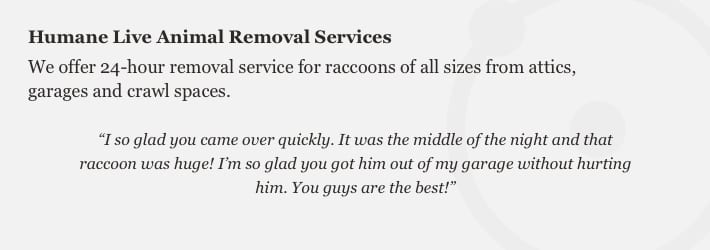
2. Put your best testimonials on your most popular pages.
Just create a path exploration report in GA4 to see the top path through your website, or look at the top pages in the pages and screens report. Put your best foot forward by putting your best evidence on your top pages.
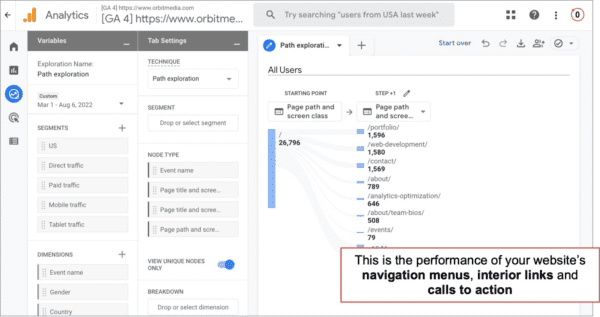
- Unsurprising, this typically means putting your best testimonials on your home page.
- Surprisingly, this typically means adding testimonials to your about page. Why not, right? Put the best stuff anywhere where people will see it.
3. Put testimonials with keyphrases on pages that are optimized for that phrase.
Every tip in this post so far is about increasing conversion rates. But this little bonus tip can increase your traffic as well. If the testimonial includes a target keyphrase, it can increase the relevance of that page for that phrase.
Here’s an example of an excerpt from a page optimized for raccoon removal service. We’ve marked in red every instance of those words, including various grammatical forms.
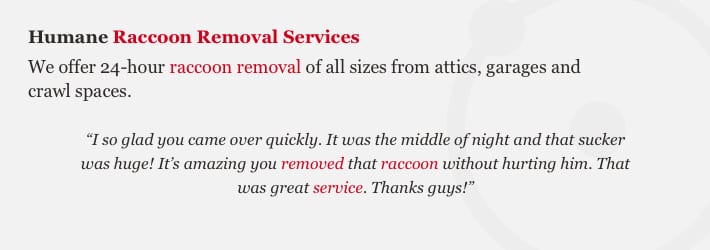
See how the testimonial can include the target phrase or related words? That can help the ranking of the page AND add social proof. That’s one of only a few tactics that can increase both traffic and conversion rates.
Positive proof
Now we know why they work, where to get them, how to write them and where to put them. Let’s wrap with a mini-guide with all the little things you can add to increase their power and credibility.
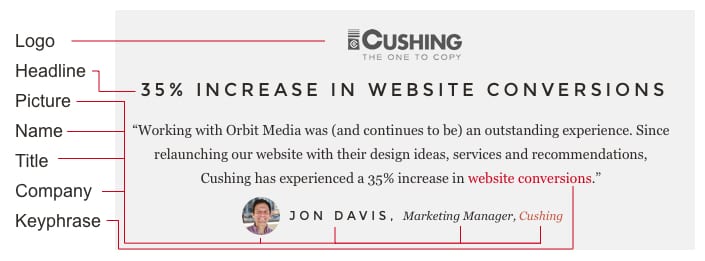
Know someone who needs these tips? Did your web designer leave a few of these out? Feel free to send this guide along to anyone who needs a more credible, higher-converting website.




